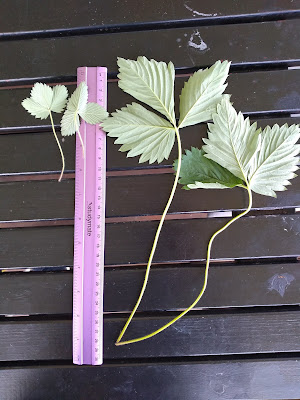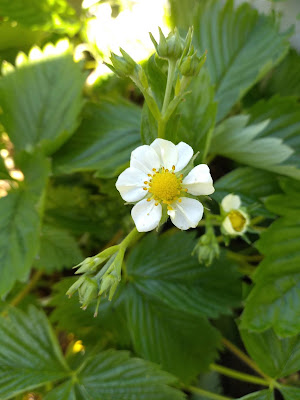I have been growing potatoes from true potato seed for a while now. I grow a few diploid potatoes, some tetraploids, and I have a wild relative of the modern potato. When grown from true seed, each and every plant is genetically unique.
Most diploid potatoes have really low yields, and produce small potatoes, but the taste of diploids is vastly superior to any variety of potato that you will have ever eaten. Modern domestic potatoes are big and bland, even the tastiest modern potato is nothing compared to a diploid.
I have been messing around with breeding diploid potatoes. I mostly grow as many as I have space to grow, cull everything substandard, each winter everything with low/no dormancy die, and I allow them to open pollinate before collecting true potato seed to plant.
Some years one variety will do better, other years another variety will do better. I am starting to get some really nice seed grown potatoes.
 |
| Amiah diploid potato compared to a modern tetraploid potato |
One of my seed grown potatoes is yielding quite well for a diploid, and produces two crops per year in my garden. It looks pretty similar to another high yielding diploid called 'toffee apple' which was bred by Garden Larder. As I originally got some true potato seed from Garden Larder my variety (named Amiah) may be closely related.
Interestingly someone recently sent me a few tubers of Toffee Apple Potato, it is yet to produce a crop for me because I planted it a bit late. It carries good genes and is flowering well so I assume some of the true potato seeds I am currently harvesting will carry some of its genetics.
 |
| Amiah potato compared to pumpkin |
Amiah diploid potato produces gorgeous looking potatoes, with rich yellow flesh, it yields surprisingly well and produces multiple crops per year, it flowers well and can produce berries and true potato seed if pollinated by a different clone.
The only real down sides to this diploid are its low dormancy and its relatively long stolons. Most of its tubers are produced under the plant but a few will spread out and be found further from the plant. To get the most out of it this plant likes a little space to run!
Compared to a modern potato, Amiah potatoes taste incredible when baked. I am bad at describing taste, all I can say is this is how a potato should taste. If I had my way I would never eat a modern domestic potato again.
 |
| I love rich yellow flesh potatoes |
We roasted this diploid potato along with some modern potatoes for comparison. The diploid looked like it was already buttered, much the same colour as pumpkin, indicating it is very high in beta carotene vitamin.
I really like the look of yellow flesh potatoes. That being said I also grow some blue flesh potatoes and some whites that are worth keeping. Hopefully a nice red flesh potato pops up soon.
When grown from rather diverse and heterozygous seed it is difficult to know what they will produce!
 |
| Amiah potatoes and the white modern tetraploid ready for roasting |
Diploid potatoes can sometimes produce small tubers. Small potatoes are frustrating to clean and difficult to use. Normally the diploids aren't too tiny, but at the start I had a couple of lines that produced pea sized tubers, needless to say I culled them from my breeding efforts pretty quickly.
Any potato grown from true seed can produce tubers with deep eyes. These are difficult to clean. Some can produce really long stolons. I have heard that some produce tubers on stolons that can be 6 foot long, making them unrealistic to grow. Luckily I have never come across anything like that.
This diploid potato produces reasonable sized tubers, nothing huge but certainly a size that is usable in the kitchen. The eyes are not very deep. The stolons are a bit longer than most varieties, but not too bad.
 |
| Amiah potatoes are a reasonable size for a diploid potato |
 |
| Amiah potatoes look nice |
I have a few extra tubers, if you are interested I should list them for sale on my for sale page along with the other perennial vegetables and things I have for sale.













































